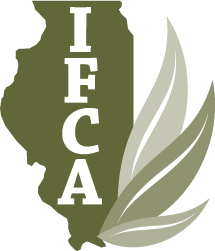June 20 Dicamba Cut-Off Approaching Quickly
With only 6 days left to make applications of Engenia, Xtendimax and Tavium, IFCA would like to pass along some friendly reminders regarding application of dicamba:
- Prohibiting over the top application of dicamba on soybeans after June 20.
- Prohibiting over the top application of dicamba on soybeans if the air temperature at the field at the time of application is over 85 degrees, or if the National Weather Service's forecasted high temperature for the nearest locations for the day of application exceeds 85 degrees. Refer to the Local National Weather Service forecasts at http://www.weather.gov.
- Requiring an approved pH-buffering agent (also called a Volatility Reduction Agent or VRA) be tank mixed with over-the-top dicamba products prior to all applications to control volatility.
- Requiring a downwind buffer of 240 feet to protect sensitive areas and 310 feet in areas where listed species are located. (IFCA Note: To clarify, Illinois has 18 endangered species counties, refer to the following map. In these counties the downwind buffer to protect sensitive areas will be 310 feet and 57 feet on all other sides of the field. All labels will still have a "do not spray" if sensitive crops are downwind.)
- The ability to use hooded sprayers to reduce the downwind buffer size. A buffer of 110 feet can be used in counties not deemed to have endangered species, and a buffer of 240 feet within counties that are designated as having endangered species.
- Before applying a pesticide containing dicamba on soybeans, the applicator shall consult the FieldWatch sensitive crop registry https://www.fieldwatch.com and comply with all associated label and recordkeeping requirements.
- Application on soybeans with a pesticide containing dicamba shall not be made if the wind is blowing toward:
- Any Illinois Nature Preserves Commission site that is adjacent to the field of application. Map of Illinois Nature Preserves Commission.
- An adjacent residential area.
For clarification, the 85-degree temperature restriction means that if the weather.gov website has a forecasted high of 86 or more for the zip code of the field to be sprayed, then the entire day is a Do Not Spray Day. In addition to looking at the graphic image of the forecasted high, you can also select the "detailed forecast." The detailed forecast in many cases may indicate "high near 86" and IDA has clarified to IFCA that "high near 86" also means 86 degrees, and thus is a Do Not Spray Day. IFCA knows that it will be a challenging week to use this product with some of the forecasted highs.
IFCA has received calls and emails the last few days asking the question if IDOA would extend the June 20th cut-off date for dicamba. The short answer to the question is no, because IDOA implemented this year’s dicamba restrictions under emergency rulemaking. IDOA would have to go through the rulemaking process again to make any changes. IDOA has made it perfectly clear that they would not be going in that direction.
We realize the pressure that ag retailers are under to apply dicamba ahead of the June 20 cut-off. Violation of either the cut-off date, temperature restriction or lack of recordkeeping will likely be considered a willful violation of the Illinois Pesticide Act. Please visit with your customers on these label requirements so that they understand the additional requirements in Illinois. If you need more information regarding dicamba application or are looking for more resources such as labels, recordkeeping forms, where to find endangered species counties or are just looking for general information, please visit IFCA’s dicamba page. If you have questions please contact KJ Johnson at (217) 369-1669.
